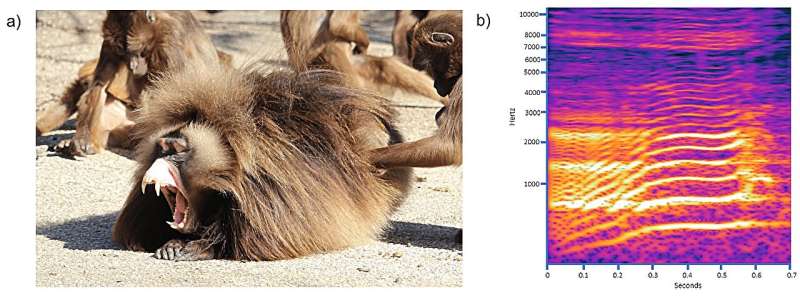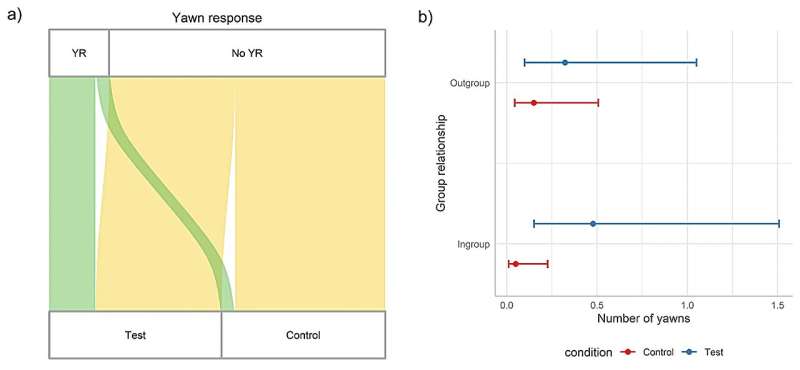January 16, 2024 feature
This article has been reviewed according to Science X's editorial process and policies. Editors have highlighted the following attributes while ensuring the content's credibility:
fact-checked
peer-reviewed publication
trusted source
proofread
Audible yawns in a non-human species may convey important social information

Most of us are familiar with yawn contagion, which is the act of spontaneous yawning when someone nearby yawns, often but not always audibly. For humans, yawning can emanate from fatigue or boredom, and either seeing or hearing someone else yawn may start a chain reaction.
Many animal species also yawn when they're tired, and yawn contagion is known to occur among various social animals including certain apes, monkeys, lemurs, pigs, wolves, domestic dogs, lions, spotted hyenas, and more. But other than humans, only one species—the gelada (Theropithecus gelada), a species of Old World monkey—is known to yawn audibly.
Earlier studies have explored yawn contagion within and between various species; for example, some work has shown that dogs will yawn in response to the sound of human yawns. But to date, there have been no known studies on intraspecific audibly-triggered yawn contagion in a non-human species.
Now a research team from France and Italy has specifically studied how the sound of gelada yawns affects their conspecifics. The team's work is published in Scientific Reports.
Geladas, also known as bleeding-heart monkeys, are endemic to Ethiopia. They live in multi-level societies that include units, teams, bands, and communities. Core units either include a single reproductive adult male with multiple adult females, their young, and at least one follower male; or only young adult and adolescent males no longer living within their birth units.
Similar to humans, geladas enjoy rich and complex vocal communication. According to the new study, "A similar evolutionary social landscape, with similar challenges (e.g., need of group coordination with subjects not always in visual contact), has indeed possibly led to the emergence of multimodal communication in both species."
Existing findings show that yawning geladas, mostly males, emit a loud vocal sound that does not arise solely from inhaling and exhaling. While the researchers behind this study knew that visually-based yawn contagion could affect geladas, they wanted to find out whether the sound of yawning without a visual cue would result in a similar effect.
Testing the effects of audible yawn sounds
The researchers hypothesized that—as with humans—as it evolved, yawn vocalization among geladas might have led to the possibility of yawn contagion among subjects who could not see each other; and moreover, that any such vocalization-based yawn contagion would adjust itself in accordance with the perceived social value of the actuating sound.

To test these hypotheses, they conducted a study at Germany's NaturZoo Rheine, which hosts a colony of 106 geladas, the largest captive colony in the world. There, the animals live in five core units (four one-male units and one male-only unit) within two adjacent enclosures, divided by a pond, that include both indoor and outdoor areas through which the geladas can roam freely. The animals in each enclosure can see and hear those in the adjacent enclosure, but cannot make physical contact with them.
From among all the units, the researchers randomly selected 33 test subjects (7 males, 26 females; 21 from one enclosure and 12 from the other) for playback experiments, conducted in the outdoor areas. Only adults were selected, as yawn contagion in geladas has only appeared among adults.
Since audible yawns come mostly from males, the researchers first recorded male yawn sounds (which can help promote group coordination, according to a 2021 study) as test vocalizations and male affiliative grunt pairs as control vocalizations. Then, controlling for multiple confounding factors, they played the sounds back to the test subjects in various conditions and observed their reactions. None of the males whose yawn sounds were used as test vocalizations were tested with their own voice recordings.
Yawn sounds as possible social cues
Notably, the findings showed that audibly-triggered yawn contagion exists among geladas. This makes them the only species other than humans to experience this phenomenon. Writing that "[the] mere sound of a yawn can trigger contagious yawning in geladas," the researchers note that compared to the control grunts, audible yawns elicited a more yawns, a higher chance of yawning, and similar levels of contagiousness in both males and females.
The researchers also confirm that the test subjects yawned more frequently in reaction to audible yawns made by individuals from their own group, indicating that group membership could be a factor in audibly-triggered yawn contagion.
While there is more to explore in this area, the team believes that audibly-triggered yawn contagion might serve a social purpose in both humans and geladas.
They write, "Considering the significance of yawning in group synchronization, the adaptive value of auditory YC [yawn contagion] might be linked to the need for individuals to maintain acoustic contact when visual contact is not possible, making this especially relevant in societies characterized by modularity and flexibility, and in species with such rich communicative repertoires."
More information: Luca Pedruzzi et al, The sound of yawns makes geladas yawn, Scientific Reports (2024). DOI: 10.1038/s41598-023-49797-5
Journal information: Scientific Reports
© 2024 Science X Network




















